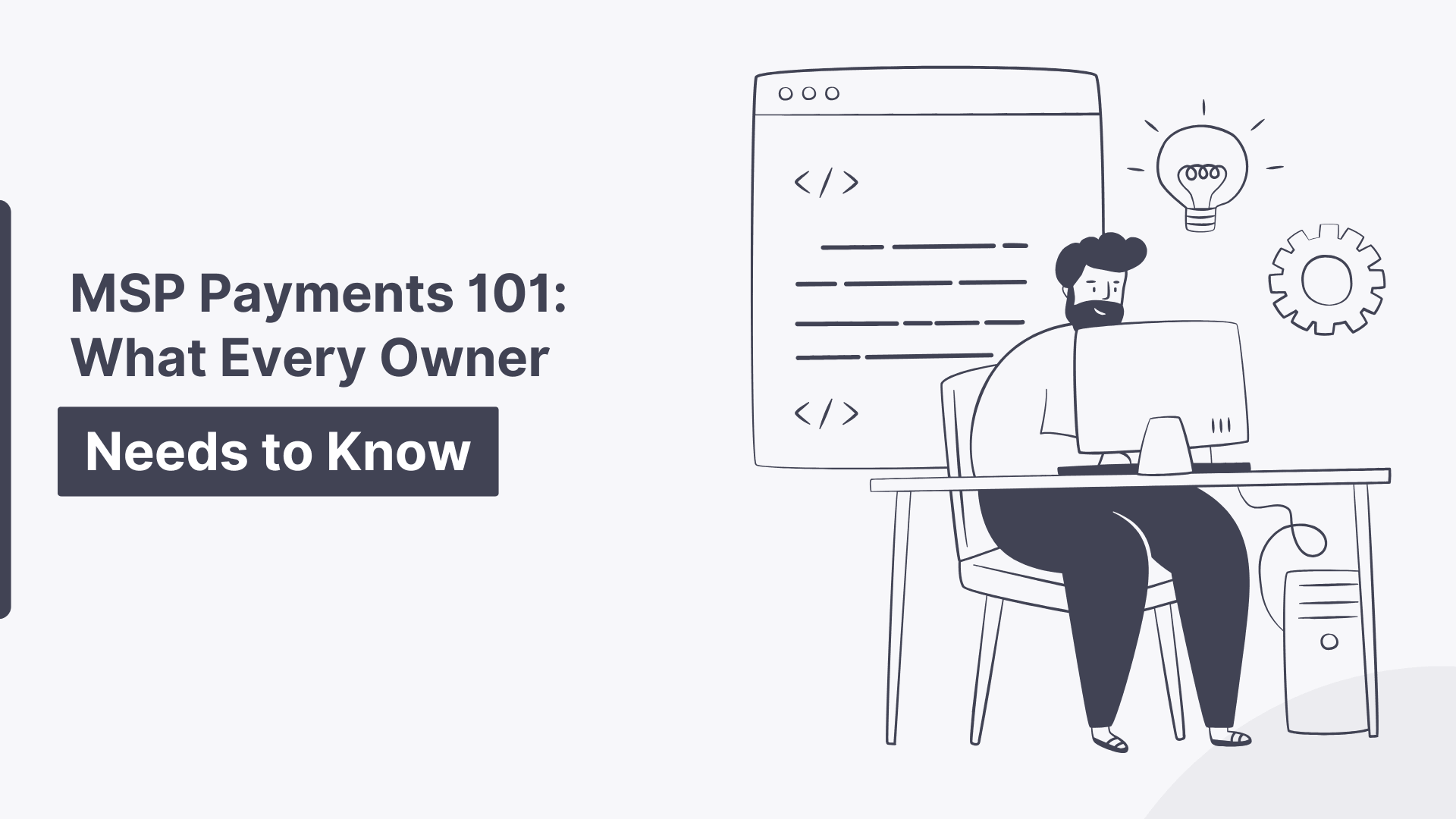Most MSPs didn’t start their business thinking about MSP payments. But as they grow, MSP billing becomes more complex and more critical. What started as a simple invoice and a check can quickly turn into a tangled web of tools, missed payments, and manual reconciliation. The problem isn’t your process—it’s that most tools weren’t built for how MSPs actually operate. This is your crash course in what “payments” really means for an MSP and how to build smarter MSP finance systems that scale with you. Because in reality, MSP payment workflows aren’t just admin tasks—they’re core infrastructure. And getting them right can change how you manage cash flow, serve clients, and run your business.
Before we dive in, let’s start with the moment most MSPs realize their payment system isn’t working: when something breaks, and no one knows where the gap is.
Payments Are Invisible, Until They Break
You don’t notice your payment systems when they’re working—just like you don’t think about plumbing until there’s a leak. But in an MSP, when even one part of your payment workflow falters—invoice errors, missed ACH batches, unclear client statements—the consequences ripple across the business. Suddenly your AR is aging, your team is wasting time chasing status updates, and your clients are confused about what they owe.
That’s the thing about payments: when they fail, they don’t just delay cash—they damage trust. And while the tech gap is often the root cause, it’s the human side that suffers most. Your bookkeeper gets burned out, your ops lead plays part-time collections agent, and your clients feel like they’re being nickel-and-dimed. All of it erodes the confidence that keeps recurring revenue truly recurring.
And the fix isn’t always obvious, because the issue usually hides between systems. One PSA field doesn’t sync. One invoice doesn’t trigger a reminder. One client gets a vague portal experience and decides to “wait until next month.”
For most MSPs, payments are a back-office afterthought—until a check goes missing, an invoice goes unpaid for 45 days, or your PSA and QuickBooks disagree on who owes what. Then suddenly, “payments” aren’t just about card processing. They’re about cash flow, client trust, and operational clarity.
If you’re still relying on paper checks, Stripe, or QuickBooks Payments, you’re not alone. But you may be underestimating what “payments” really mean inside an MSP business.
Before long, what started as one missed payment turns into a recurring pattern—and “good enough” payment tools start to show their cracks. That’s when the real cost of manual workarounds and generic processors comes into focus.

The Real Cost of ‘Good Enough’
In most industries, payment systems just need to process a transaction. MSPs are different. You deal with recurring invoices, contract-based billing, ticket disputes, and PSA syncs—not to mention clients who want flexibility without surprises.
And yet, many MSPs still piece together their payment stack from generic tools that weren’t built for the complexity of your service model. Stripe may collect a card. QuickBooks might show the deposit. But who’s tracking partial payments? Matching to agreements? Closing the loop between invoice and reconciliation?
The cost of these gaps isn’t just inefficiency—it’s aging accounts receivable, missed revenue, and the illusion of profitability. And it adds up faster than most owners realize. We’ve watched hundreds of MSPs lose an average of 15-20 hours per month to manual reconciliation alone—that’s $1,500-3,000 in opportunity cost every billing cycle. Clients who don’t have a smooth payment experience pay 23% slower on average. Finance reviews stretch into late nights and late closes, with 67% of MSPs reporting they can’t close their books until day 10 or later each month.
What’s worse, “good enough” tends to hide the problems. A Stripe deposit might look clean in your bank feed, but without clarity across systems, you don’t know what it covered—or what’s still unpaid. That disconnect between what your PSA says and what your books reflect is where margin leaks begin.
Let’s bring that home: You’ve billed $15,000 through Autotask, but QuickBooks only shows $12,800 deposited. Why? Because ACHs were delayed, a credit card declined, and a partial payment got missed entirely. Now you’re logging into three systems and calling two clients just to figure out what actually got paid. That’s the real cost of “good enough.”
“Good enough” tools create the illusion of clarity until they don’t. A Stripe deposit might hit your bank, but there’s no easy way to tell which client, invoice, or service period it actually covered. Your PSA says one thing, your books another, and your team is left stitching together context from three systems and a few forwarded emails. The real risk? You start making decisions on cash that isn’t truly collected—or worse, redoing work that’s already been paid for but never properly tracked.
These aren’t just back-office annoyances. They’re margin leaks. When your ops lead becomes your part-time collections manager, or when your best tech spends an hour a week reconciling payments, you’re paying twice: once in time, and again in lost billables. And when client confusion delays payments by a week or a month—that cash flow drag hits your ability to hire, invest, or even pay yourself predictably.
That’s the hidden cost of “good enough.” Before you can fix your payment system, you have to understand what it’s actually made of. And for MSPs, it’s more than just a swipe or a transfer—it’s a workflow that stretches across your entire business.
What ‘Payments’ Actually Mean in an MSP
Let’s zoom out. “Payments” in an MSP business isn’t just what happens at the point of transaction. It’s the entire lifecycle:
Invoice issuance: Generated from your PSA, ideally error-free and on schedule.
Client communication: Clear, timely, and frictionless—ideally with reminders baked in.
Payment collection: Cards, ACH, bank transfers—whatever’s fastest and lowest-cost.
Reconciliation: Syncing back to accounting, tracking who paid what, and when.
Reporting: Visibility into aging, disputes, and trends—not just balances.
Every step in that lifecycle either builds momentum or creates drag. If invoicing isn’t timely or clear, clients delay. If payment options aren’t intuitive or affordable, they resist. If reconciliation doesn’t close the loop, finance loses visibility. It’s not just about what’s happening at each stage—it’s about how well those stages connect.
Most MSPs don’t realize how many touchpoints they’re managing until something breaks: sending the invoice, delivering the reminder, receiving the payment, logging the match, resolving the dispute, closing the books. Each of those steps is a handoff between systems—and every handoff is a chance for friction.
When the payment lifecycle is optimized, it unlocks a downstream ripple effect: fewer tickets from confused clients, more consistent collections, less time in spreadsheets. Your PSA, portal, and accounting system work as one. And suddenly, “payments” go from reactive to reliable—from chaos to confidence.
But more than that, payments sit at the intersection of service delivery, client experience, and financial health. When payments run smoothly, they reinforce your professionalism. When they don’t, even great service can feel disorganized.
For example: a clean invoice that clearly maps to a service agreement not only speeds up payment—it builds trust. It says, “We’re on top of this.” On the flip side, confusing charges or missing context invite scrutiny, delay, and even disputes.
This is why getting paid isn’t just about how you charge—it’s about how clearly you communicate value. And that’s especially true in a recurring revenue model, where the goal isn’t just one-time payment, but long-term consistency.
Payments also impact internal clarity. When finance, ops, and service teams are aligned around a reliable payment process, month-end becomes a routine—not a scramble. You close faster. Forecast better. Plan ahead. In short, you operate like a business, not a billing machine.
When any part of that chain breaks, you’re left chasing payments, plugging data gaps, or paying fees you didn’t budget for. And that’s what makes MSP-specific tools essential.
Before we can talk about better tools, we have to be honest about the ones most MSPs are using today. The tools that feel “good enough” often come with hidden trade-offs—ones that only show up when aging invoices stack up or reconciliation becomes a monthly fire drill. That’s where general-purpose solutions fall short.

Why General Tools Don’t Cut It
Stripe is sleek, but it treats every invoice like a one-off eCommerce transaction. There’s no awareness of your PSA, no context for service periods, and no help resolving mismatches between work performed and payment received.
QuickBooks Payments is convenient—for QuickBooks. But reconciling invoices from ConnectWise or Autotask requires manual imports and error-prone mapping. We’ve seen MSPs spend hours each month just trying to match Autotask invoice numbers to QuickBooks transactions, especially when partial payments or failed payments create data mismatches. And when ConnectWise billing periods don’t align perfectly with your accounting system’s invoice structure? That’s where the real headaches begin.
Even client portals from accounting systems feel like relics. They weren’t designed for ticket-heavy, monthly-recurring-service environments. And when your clients can’t easily view, pay, or understand their bill, they pay late—or not at all.
Let’s clarify one of the biggest misconceptions:
Processors: Collect money
Portals: Facilitate how clients pay and view invoices
Purpose-built MSP portals: Tie together PSA, accounting, and client experience in one flow
One MSP we work with shaved 12 days off their average collection time—just by making ACH easier to use than cards. That’s what happens when your payment system respects how MSPs operate.
And here’s the deeper issue: general tools treat your invoices like commodities, not contracts. They don’t understand retainers, time entries, or partial service delivery. So they can’t reflect your actual agreements or protect your margin when there’s a dispute.
Most general-purpose tools also fall short on integrations. They weren’t built to speak the language of MSP billing platforms like Autotask or ConnectWise, and they certainly weren’t built to maintain real-time sync across systems. When your ConnectWise time entries don’t automatically flow to invoicing, or when Autotask contract billing doesn’t sync with your payment portal, you’re stuck reconciling by spreadsheet—a process that typically adds 8-12 hours to month-end close cycles.
The client experience also suffers. Generic portals often require login gymnastics or manual reminders. They don’t surface invoice clarity or offer preferred payment methods. When your client has to work to pay you, they’ll pay you slower.
And when these gaps create friction, most MSPs blame their clients or their AR person—rather than seeing the root issue: they’re using tools not designed for their business model. It’s not just a tech problem. It’s a system design problem.
The better approach? Start with the reality of how MSPs operate, then reverse-engineer the payment experience from there. That’s the shift that unlocks trust, speed, and financial clarity.
When you step back and see where general tools fall short, the next question becomes clear: what would a tool built specifically for MSPs actually look like? The answer isn’t just more features—it’s alignment with how your business works at every level.
What Makes a Tool MSP-Specific
Not all payment platforms are created equal—and that’s especially true for MSPs. The workflows, client expectations, and billing structures in a managed services business are unlike anything general-purpose tools were built to handle. You’re not running a retail checkout. You’re managing recurring revenue, variable service items, and technical labor—all tied back to contracts. That’s why a purpose-built approach matters.
An MSP billing system that’s truly purpose-built understands:
- Contracted recurring revenue (and how to bill against it)
- Time and materials nuance (and how to show it clearly)
- PSA and IT accounting system syncs (and how to maintain them without manual effort)
- Client experience standards (and how to remove friction from every bill)
- PCI compliance requirements without sacrificing payment flexibility
These aren’t just feature checkboxes—they’re operational enablers. Because when MSP billing, payments, and reconciliation flow together, MSP finance operations become a multiplier. You don’t just save time—you unlock predictability. We’ve observed that MSPs with integrated billing workflows reduce their accounts receivable aging by an average of 18 days and improve collection rates by 12-15%.
What makes these tools “MSP-specific” is that they think in service agreements, not products. They account for service period logic, block hours, hardware pass-throughs, and one-off labor—all in one invoice. And they show it in a way clients can understand.
They also respect the source of truth: your PSA. Instead of duplicating data entry, they sync natively with the platforms you already live in. No more second-guessing what’s due, when, or for what.
And then there’s reporting. MSP finance tools give you clarity on aging, collections, and cash flow trends at a glance—not just bank deposits. That means fewer surprises and faster decisions when you’re managing growth. The best systems provide real-time visibility into collection efficiency, payment automation success rates, and vendor payments reconciliation—typically reducing month-end close time by 40-60%.

Most importantly, these tools are built with recurring revenue models in mind. They support automated workflows, monthly billing cycles, and client behavior patterns unique to MSPs—so your finance ops can scale as smoothly as your services.
Generic tools handle transactions. MSP-specific tools manage trust. When your invoicing reflects exactly what was agreed in your PSA—and your client can see that clearly—it reinforces your professionalism. When it doesn’t, clients hesitate, dispute, or delay. That’s not just a billing issue. It’s a confidence issue.
A generic workflow might look like this: your PSA generates the invoice, someone manually emails it, a client pays via Stripe, and your bookkeeper tries to reconcile the payment days later in QuickBooks. Compare that to an MSP-specific flow: invoices auto-generate, surface in a branded portal, match to agreements, and sync back to your GL. No gaps. No second-guessing.
And when those systems don’t talk to each other? Someone—your ops lead, your finance manager, maybe even you—has to become the middleman. That’s time not spent coaching your team, closing new business, or improving service. It’s death by a thousand pivots.
MSP-specific doesn’t mean niche. It means purpose-built. It means every part of your workflow respects how you bill, how you serve, and how you grow. When the right systems are in place, you stop chasing accuracy and start acting on insight.
That’s the leap most MSPs are ready for, even if they haven’t made it yet. The tools exist. The shift is possible. It starts with believing your finance ops deserve the same level of precision and scalability as your tech stack.
When your billing, collections, and reconciliation are fully aligned, month-end closes don’t get pushed—and you stop using ‘collections’ as a calendar reminder.
That’s why the solution isn’t just about fixing a few broken links—it’s about embracing a payment system that’s purpose-built to support the way your MSP actually runs. And that brings us to the model we’ve seen work best.
The Alternative Payments Way
This is exactly why we talk about fixing MSP finance operations first. Your billing stack is your cash stack. And MSPs deserve tools that respect that—from invoice to payment to reconciliation.
We built Alternative Payments to mirror that belief. Not by bolting features onto generic processors, but by solving for the real-world MSP billing workflows you deal with every month.
Our approach starts with your PSA. We ensure invoices are synced automatically, mapped accurately, and surfaced to clients in a clear, actionable format. No more babysitting CSV exports or hand-coding invoice fields between Autotask and QuickBooks. The result? MSPs typically see 28% faster invoice delivery and 34% fewer client billing inquiries.
Then we layer in client-first payment experiences—ACH by default, cards when needed, flexible options when it helps close the gap. Because when it’s easy to pay, clients do it faster. Our data shows that payment automation with preferred methods reduces average collection time by 11-16 days.
Behind the scenes, we automate reconciliation. Every payment maps back to your accounting system, every transaction matches to its invoice, and your team finally gets to trust the numbers they see.
But what sets this model apart is the operational mindset. Alternative Payments isn’t just a processor—it’s a system enabler. We’re not here to collect fees. We’re here to eliminate friction, surface clarity, and give you a billing engine that matches the professionalism of your service delivery.
It’s a shift from duct-taped tools to deeply integrated workflows. From “we get paid eventually” to “we know exactly who paid what and when.” That’s the Alternative Payments way.
When you rethink payments through the lens of your service model—and not just transactions—the right path forward becomes clear. It’s not about adding another tool. It’s about aligning the way you bill, collect, and reconcile with how your MSP actually operates.

It’s Time to Get Smarter About Payments
If you’ve outgrown spreadsheets and Stripe links, you’re not doing it wrong—you’ve just hit the limits of tools that weren’t built for you.
Most MSPs don’t realize how much better it can be until they see it. Payments that post automatically. Invoices that explain themselves. Clients who pay without being chased. That’s not wishful thinking—it’s what financially mature MSPs already expect.
And it doesn’t require ripping out your tech stack. You don’t need to abandon your PSA or accounting system. You just need the layer that bridges the gap—built by people who understand your business.
Getting smarter about payments means recognizing that finance isn’t a back-office function—it’s a growth driver. When payments are clean, cash flow is predictable. When reconciliation is automatic, financial reviews get strategic. When your systems speak the same language, you stop managing around the gaps.
That’s the path forward: clarity, speed, and client experience working in sync. And it starts with rethinking payments not as a necessary evil, but as a key part of how you scale.
If this article resonated, it’s worth exploring more. We dive deeper into margin preservation in “Cash Flow Is Reality” and dissect the true impact of card processing fees in “The Truth About Credit Card Fees.”
This is the kind of clarity we build into Alternative Payments. And it’s the starting point for everything we teach in our MSP Financial Academy and unpack in Office Hours. Worth a listen.
Ready to Stop Managing Around the Gaps?
You’ve seen what MSP-specific payments really look like—and why generic tools just can’t keep up.
When billing, collection, and reconciliation are built to work together, everything changes: cash flow steadies, trust grows, and your finance ops actually scale with your business.
We’d love to show you how that plays out in your stack—no guesswork, no pitch.

